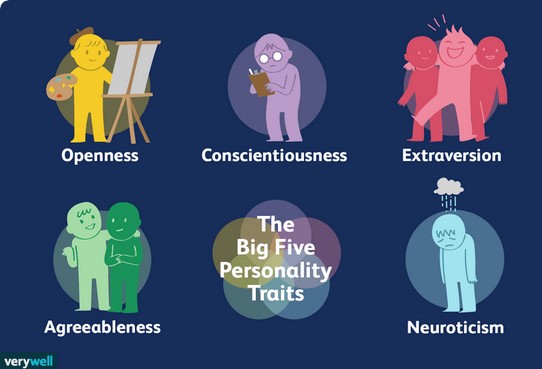Personality Traits (fundamental 5)
Introduction
The 5 are Openness, Conscientiousness, Extraversion, Agreeableness and Neuroticism
A study found
“…Looking at people in more than 50 different cultures found that 5 dimensions could be accurately used to describe personality…”
Kendra Cherry, 2025
In addition to the universal application, they are thought to have biological origins, ie they represent the most important qualities that shape our social landscapes and which helped our ancestors to survive.
“…Having different levels of each trait may provide different evolutionary advantages depending on the situation and environment…”
Kendra Cherry, 2025
One study looking at twins (123 pairs of identical twins and 127 pairs of fraternal twins found
“…The heritability of each personality trait was 53% for extraversion, 41% for agreeableness, 44% for conscientiousness, 41% for neuroticism and 61% for openness…… Longitudinal studies also suggest that these big five personality traits tend to be relatively stable over the course of adulthood…”
Kendra Cherry, 2025
The 5 fundamental dimensions of personality
They are outlined below, commonly remembered by the acronym OCEAN:
- Openness (the degree to which a person is imaginative, curious, insightful, open to new experiences, and willing to engage with novel ideas, feelings, and values.)
- Conscientiousness (the extent to which a person is organized, dependable, disciplined, and goal-oriented, showing a preference for planned rather than spontaneous behaviour.)
- Extraversion (the level of sociability, excitability, talkativeness, assertiveness; high amounts of emotional expressiveness like enthusiasm, particularly in social situations and when seeking stimulation; outgoing; being around others energises and excites them.)
- Agreeableness (it reflects an individual’s tendency to be compassionate, kind, cooperative, trusting, and eager to maintain social harmony.)
- Neuroticism (the degree to which a person experiences negative emotions like sadness, moodiness, anxiety, anger, or depression, and their general emotional stability and resilience.)

(source: Kendra Cherry, 2025)
Each trait exists on a continuum, with individuals exhibiting varying degrees of each. Usually, most people lie within the middle range.
These traits are considered universal and biologically rooted, shaped by both genetics and environment, and generally stable throughout adulthood.
More detail on each trait, including characteristics associated with high and low levels:
- Openness to Experience
- High Openness (individuals are imaginative, curious, and open to new experiences; they tend to be creative; enjoy exploring novel ideas and abstract concepts; and a broad range of interests.)
- Low Openness (individuals prefer routine and familiarity; they may be more conventional and resistant to change or new ideas; not very imaginative; dislike abstract or theoretical concepts.)
- Conscientiousness
- High Conscientiousness (these individuals are organized, well prepared, dependable, and disciplined; they are goal-oriented and exhibit strong self-control; are mindful of detail; display a high level of thoughtfulness, ie consider how their behaviour can impact others; conscious of deadlines; prefer set schedules.)
- Low Conscientiousness (individuals may be more spontaneous, less organized, less structured and may struggle with planning and following through on tasks; may procrastinate when doing things; sometimes miss deadlines; can be messy.)
- Extraversion
- High Extraversion (extraverts are outgoing, energetic, and enjoy social interactions; they often feel energized by being around others; enjoy being the centre of attention; enjoy meeting new people; have a wide social circle of friends and acquaintances; find it easy to make new friends; say things before thinking about them.)
- Low Extraversion (Introversion) (introverts may be more reserved, prefer solitude, and may feel drained by excessive social interaction; find it difficult to start conversations; dislike small talk; carefully thinks things through before speaking; dislikes being the centre of attention.)
- Agreeableness
- High Agreeableness (individuals are compassionate, cooperative, and value getting along with others, ie empathetic and sympathetic; they are often trusting and helpful; interested in other people and their happiness.)
- Low Agreeableness (individuals may be more competitive, sceptical, and less concerned with others' well-being; have little sympathy or empathy; manipulate others; willing to belittle and insult others.)
- Neuroticism
- High Neuroticism (these individuals may experience emotional instability, anxiety, moodiness, stress and irritability; negative mindset, eg worriers, easily upset, display dramatic shifts in moods, have little resilience.)
- Low Neuroticism (individuals tend to be emotionally stable, calm, and resilient to stress; rarely sad or depressed; don't worry too much; relaxed.)
Generally, people fall into one of 4 main types:
- Average (the most common type is characterised by high levels of extroversion and neuroticism and low levels of openness.)
- Self-centred (high in extraversion and low in conscientiousness, openness and agreeableness.)
- Reserved (low in extroversion, neuroticism and openness, and high in conscientiousness and agreeableness)
- Role models (high on all traits other than neuroticism)
Other personality trait models include:
- MBTI (Myers-Briggs Type Indicator): Traits like introversion vs. extraversion, thinking vs. feeling.
(for more detail, see elsewhere in Knowledge Base)
- HEXACO Model: Adds Honesty-Humility to the Big Five.
- DISC Model: Focuses on Dominance, Influence, Steadiness, and Conscientiousness.
In change processes, matching personality traits with expertise required is important. Below is an example, the desired level is in purple, while a person's results are in red on several personality traits. The result shows some gaps:

(main source: Kendra Cherry, 2025)
